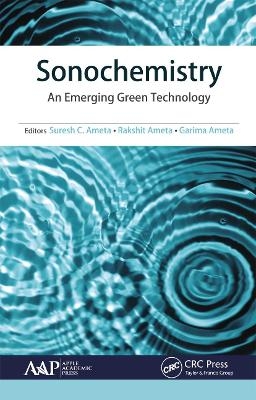
Sonochemistry
An Emerging Green Technology
Seiten
2021
Apple Academic Press Inc. (Verlag)
978-1-77463-070-9 (ISBN)
Apple Academic Press Inc. (Verlag)
978-1-77463-070-9 (ISBN)
Traditionally heat and light are thought as energy sources to drive a particular chemical reaction, but now ultrasound is a promising energy source for this purpose. The collapse of a bubble generates a wide range of high temperatures and pressures, and therefore, use of ultrasound has a considerable potential in chemical and allied sciences. Ultrasound-assisted reactions are green and economically viable alternatives to conventional techniques. This new volume presents a complete picture of ultrasound-assisted reactions and technologies that can be used in organic synthesis, polymer synthesis and degradation, nanomaterials, wastewater treatment, food ingredients and products, pharmaceutical applications, bioenergy applications, and more. This volume aims to shed light on the diversified applications of ultrasound and its significant role as a green chemical pathway.
Sonochemistry deals with the effect of ultrasonic waves on chemical systems. It has green value because of non-hazardous acoustic radiation and is therefore duly recognized as a green chemistry by synthetic chemists as well as environmentalists. There is no direct interaction of ultrasound with molecular species, but the observed chemical and physical effects of ultrasound are due to the cavitational collapse, which produces drastic conditions of temperature and pressure locally. It induces the formation of various chemical species, which cannot be easily attained under conventional conditions. Sometimes, these species are responsible for driving towards an unusual reactivity in molecular entities.
This book, Sonochemistry: An Emerging Green Technology, provides the complete development of sonochemistry, starting with an introduction and basic concepts of sonochemistry and proceeding on to different types of sonochemical reactions, instrumentation, use of ultrasound in driving particular chemical reactions, and its applications in various fields, such as polymer synthesis, decontamination of water and wastewater, preparation of nanomaterials, food technology, pharmaceutical sciences, etc.
The book also briefly discusses some areas that utilize ultrasounds of different frequencies. These include food products and their processing; anaerobic digestion of waste; and medical applications such as ultrasonography, sonodynamic therapy, drug delivery, etc. Sonochemistry will be successfully used on an industrial scale in pharmaceutical drugs, polymers, nanomaterials, food technology, material science, biogas production, etc. in years to come and will be an established green chemical technology of the future.
Sonochemistry deals with the effect of ultrasonic waves on chemical systems. It has green value because of non-hazardous acoustic radiation and is therefore duly recognized as a green chemistry by synthetic chemists as well as environmentalists. There is no direct interaction of ultrasound with molecular species, but the observed chemical and physical effects of ultrasound are due to the cavitational collapse, which produces drastic conditions of temperature and pressure locally. It induces the formation of various chemical species, which cannot be easily attained under conventional conditions. Sometimes, these species are responsible for driving towards an unusual reactivity in molecular entities.
This book, Sonochemistry: An Emerging Green Technology, provides the complete development of sonochemistry, starting with an introduction and basic concepts of sonochemistry and proceeding on to different types of sonochemical reactions, instrumentation, use of ultrasound in driving particular chemical reactions, and its applications in various fields, such as polymer synthesis, decontamination of water and wastewater, preparation of nanomaterials, food technology, pharmaceutical sciences, etc.
The book also briefly discusses some areas that utilize ultrasounds of different frequencies. These include food products and their processing; anaerobic digestion of waste; and medical applications such as ultrasonography, sonodynamic therapy, drug delivery, etc. Sonochemistry will be successfully used on an industrial scale in pharmaceutical drugs, polymers, nanomaterials, food technology, material science, biogas production, etc. in years to come and will be an established green chemical technology of the future.
Suresh C. Ameta, Rakshit Ameta, Garima Ameta
Introduction. Basic Concepts. Instrumentation. Organic Synthesis. Inorganic, Coordination and Organometallic Compounds. Nanomaterials. Polymers. Wastewater Treatment. Food Technology. Anaerobic Digestion. Medical Applications. Industrial Applications. Sonochemistry: A Versatile Approach.
| Erscheinungsdatum | 06.04.2021 |
|---|---|
| Zusatzinfo | 11 Tables, black and white; 6 Illustrations, color; 42 Illustrations, black and white |
| Verlagsort | Oakville |
| Sprache | englisch |
| Maße | 152 x 229 mm |
| Gewicht | 453 g |
| Themenwelt | Medizin / Pharmazie ► Medizinische Fachgebiete ► Arbeits- / Sozial- / Umweltmedizin |
| Studium ► Querschnittsbereiche ► Klinische Umweltmedizin | |
| Naturwissenschaften ► Biologie | |
| Naturwissenschaften ► Chemie ► Organische Chemie | |
| Technik ► Elektrotechnik / Energietechnik | |
| Technik ► Umwelttechnik / Biotechnologie | |
| ISBN-10 | 1-77463-070-2 / 1774630702 |
| ISBN-13 | 978-1-77463-070-9 / 9781774630709 |
| Zustand | Neuware |
| Haben Sie eine Frage zum Produkt? |
Mehr entdecken
aus dem Bereich
aus dem Bereich
Buch | Softcover (2023)
American Psychological Association (Verlag)
CHF 176,30
An Interdisciplinary Textbook
Buch | Softcover (2024)
Oxford University Press (Verlag)
CHF 69,80
The New Science of the Microbiome
Buch | Softcover (2023)
Penguin Life (Verlag)
CHF 29,65


